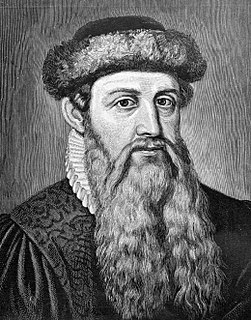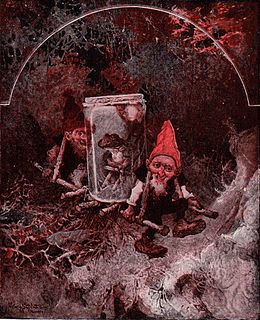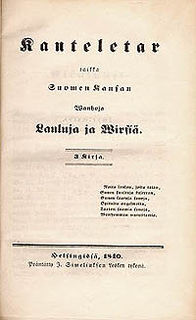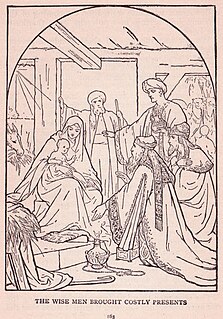
Johannes Gensfleisch zur Laden zum Gutenberg was a German inventor, printer, publisher, and goldsmith who introduced printing to Europe with his mechanical movable-type printing press. His work started the Printing Revolution in Europe and is regarded as a milestone of the second millennium, ushering in the modern period of human history. It played a key role in the development of the Renaissance, Reformation, Age of Enlightenment, and Scientific Revolution, as well as laying the material basis for the modern knowledge-based economy and the spread of learning to the masses.
The Stratemeyer Syndicate was a publishing company that produced a number of mystery book series for children, including Nancy Drew, The Hardy Boys, the various Tom Swift series, the Bobbsey Twins, the Rover Boys, and others. They published and contracted the many pseudonymous authors doing the writing of the series from 1899 through 1987, when the syndicate partners sold the company to Simon & Schuster.

A picture book combines visual and verbal narratives in a book format, most often aimed at young children. With the narrative told primarily through text, they are distinct from comics, which do so primarily through sequential images. The images in picture books can be produced in a range of media, such as oil paints, acrylics, watercolor, and pencil.

The Beinecke Rare Book & Manuscript Library is the rare book library and literary archive of the Yale University Library in New Haven, Connecticut. It is one of the largest buildings in the world dedicated to rare books and manuscripts. Established by a gift of the Beinecke family and given its own financial endowment, the library is financially independent from the university and is co-governed by the University Library and Yale Corporation.

The Gutenberg Bible was the earliest major book printed using mass-produced movable metal type in Europe. It marked the start of the "Gutenberg Revolution" and the age of printed books in the West. The book is valued and revered for its high aesthetic and artistic qualities as well as its historical significance. It is an edition of the Latin Vulgate printed in the 1450s by Johannes Gutenberg in Mainz, in present-day Germany. Forty-nine copies have survived. They are thought to be among the world's most valuable books, although no complete copy has been sold since 1978. In March 1455, the future Pope Pius II wrote that he had seen pages from the Gutenberg Bible displayed in Frankfurt to promote the edition, and that either 158 or 180 copies had been printed.

The Children's Encyclopædia was an encyclopaedia originated by Arthur Mee, and published by the Educational Book Company, a subsidiary of Northcliffe's Amalgamated Press, London. It was published from 1908 to 1964. Walter M. Jackson's company Grolier acquired the rights to publish it in the U.S. under the name The Book of Knowledge (1910).

Just So Stories for Little Children is a 1902 collection of origin stories by the British author Rudyard Kipling. Considered a classic of children's literature, the book is among Kipling's best known works.

The Gutenberg Galaxy: The Making of Typographic Man is a 1962 book by Marshall McLuhan, in which the author analyzes the effects of mass media, especially the printing press, on European culture and human consciousness. It popularized the term global village, which refers to the idea that mass communication allows a village-like mindset to apply to the entire world; and Gutenberg Galaxy, which we may regard today to refer to the accumulated body of recorded works of human art and knowledge, especially books.

Howard Pyle was an American illustrator and author, primarily of books for young people. He was a native of Wilmington, Delaware, and he spent the last year of his life in Florence, Italy.
Henrietta Elizabeth Marshall was a British author, particularly well known for her works of popular national history for children. She is best known for her 1905 work "Our Island Story", which was published abroad as An Island Story: A Child's History Of England.

Raymond Fisher Jones was an American science fiction author. He is best known for his 1952 novel This Island Earth, which was adapted into the eponymous 1955 film.

Miles John Breuer was an American physician and science fiction writer of Czech origin. Although he had published elsewhere since the early 20th century, he is considered the part of the first generation of writers to appear regularly in the pulp science fiction magazines, publishing his first story, "The Man with the Strange Head", in the January 1927 issue of Amazing Stories. His best known works are "The Gostak and the Doshes" (1930) and two stories written jointly with Jack Williamson, "The Girl from Mars" (1929) and The Birth of a New Republic (1931).

The Book of the Thousand Nights and a Night (1885), subtitled A Plain and Literal Translation of the Arabian Nights Entertainments, is an English language translation of One Thousand and One Nights – a collection of Middle Eastern and South Asian stories and folk tales compiled in Arabic during the Islamic Golden Age – by the British explorer and Arabist Richard Francis Burton (1821–1890). It stood as the only complete translation of the Macnaghten or Calcutta II edition of the "Arabian Nights" until the Malcolm C. and Ursula Lyons translation in 2008.

City of Gold and other stories from the Old Testament is a collection of 33 Old Testament Bible stories retold for children by Peter Dickinson, illustrated by Michael Foreman, and published by Victor Gollancz Ltd in 1980. The British Library Association awarded Dickinson his second Carnegie Medal recognising the year's outstanding children's book by a British subject and highly commended Foreman for the companion Kate Greenaway Medal.
Hans Peter Kraus, also known as H. P. Kraus or HPK, was an Austrian-born book dealer described as "without doubt the most successful and dominant rare book dealer in the world in the second half of the 20th century" and in a league with other rare book dealers such as Bernard Quaritch, Guillaume de Bure and A.S.W. Rosenbach. Kraus specialized in medieval illuminated manuscripts, incunables, and rare books of the 16th and 17th centuries, but would purchase and sell almost any book that came his way that was rare, valuable and important. He prided himself in being "the only bookseller in history...to have owned a Gutenberg Bible and the Psalters of 1457 and 1459 simultaneously," stressing that "'own' here is the correct word, as they were bought not for a client's account but for stock."

The 36-line Bible, also known as the "Bamberg Bible", was the second moveable-type-printed edition of the Bible. It is believed to have been printed in Bamberg, Germany, circa 1458–1460. No printer's name appears in the book, but it is possible that Johannes Gutenberg was the printer.

Kanteletar is a collection of Finnish folk poetry compiled by Elias Lönnrot. It is considered to be a sister collection to the Finnish national epic Kalevala. The poems of Kanteletar are based on the trochaic tetrameter, generally referred to as "Kalevala metre".
Logan Marshall, was the pen name of Logan Howard-Smith of Germantown, Philadelphia, Pennsylvania. Howard-Smith was the son of Robert Spurrier and Elizabeth (McKinney) Howard-Smith. The father was an executive of Link-Belt.

Children's Bibles, or Bibles for children, are often collections of Bible stories rather than actual translations of the Bible aimed at children.















